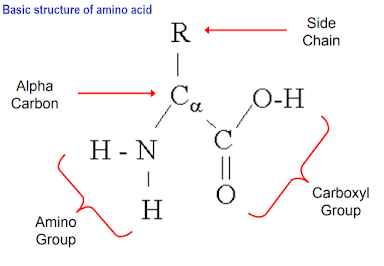In most biological processes on the molecular, cellular or organism level, proteins are the main actors, and it is therefore important to understand their function. The function of a protein is determined by its structure.
Proteins contain Carbon, Hydrogen, Oxygen and Nitrogen as the major components while Sulfur and Phosphorus are minor constituents. Nitrogen is characteristic of proteins. The variety of protein structures is made possible by the order and arrangement of the amino acid building blocks. All amino acids have the same basic structure.
Proteins are polymers: similar molecules (called monomers) are repeated many times to form a chain. Chains that are less than 40-50 amino acids or residues are often referred to as polypeptide chains since they are too small to form a functional domain. Larger than this size, they are called proteins.
Each polypeptide chain has a unique amino acid sequence decided by the genes. The primary structure is maintained by the covalent bonds of the peptide linkages.
Amino acids (except glycine) contain a central chiral carbon, i.e., a carbon atom covalently linked to four different groups of atoms, often called carbon α (Cα). This central chiral atom is linked to an amino group and a carboxylic acid group, thus the term amino acid.
The sequence of amino acid side chains gives proteins unique properties. They not only determine the fold of the protein, but they also determine surface properties that are important for selective interactions with other molecules and catalysis of chemical reactions.
Generally, the polypeptide chains are linear. However branching points in the chains may be produced by interchain disulphide bridges. The covalent disulphide bonds between different polypeptide chains in the same protein (interchain) or portions of the same polypeptide chain (intrachain) are also part of the primary structure.
Structure of protein
The primary goal of food is to promote our health and general well-being. Food science entails comprehending the characteristics, composition, and behaviors of food constituents in different situations, such as storage, handling, and consumption.
December 27, 2020
The Most Popular Posts
-
Crude fiber is a measure of the quantity of indigestible cellulose, pentosans, lignin, and other components of this type in present foods. ...
-
Of the many foods obtained from the land, humans tend to prefer animal foods, mainly beef, pork, poultry and mutton as well as their by-pr...
-
Crude fat is the term used to refer to the crude mixture of fat-soluble material present in a sample. Crude fat also known as the ether ext...
-
Gelatinization occurs when starch granules are heated in a liquid. It is responsible for the thickening of food systems. The process is an i...
-
Ash or mineral content is the portion of the food or any organic material that remains after it is burned at very high temperatures. The a...
-
-
-
Most American today are overfed yet undernourished, which eventually leads to obesity and poor health. The answer to those pervasive problem is simply to ...







